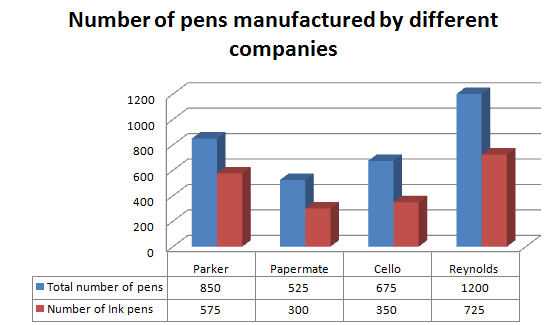Directions(1-5): Answer the following questions based on the given information.
The graph shows the number of pens (ball point pens and ink pens) manufactured by five different companies on Wednesday.

- What is the average number of ball point pens manufactured by Cello and Parker together on Wednesday?
220180200285300Option E
Number of ball point pens manufactured by Cello and Parker on Wednesday = 325 and 275
Required average number of ball point pens = 325+275/2 = 300 - What is the difference between the total number of ink pens manufactured by Reynolds and Paper mate together and the total number of ink pens manufactured by Cello and Camlin together on Wednesday?
1520254430Option C
Number of ink pens manufactured by Reynolds and Paper mate together = 725+300 = 1025
Number of ink pens manufactured by Cello and Camlin together = 350+650 = 1000
Required Difference = 25 - What is the average number of pens manufactured by Cello, Camlin and Paper mate together on Wednesday?
650700555620500Option B
Average = (675+900+525)/3 = 700 - The number of ink pens manufactured by Cello on Wednesday is what percent more or less than the number of ball point pens manufactured by Camlin on Wednesday?
70%60%20%40%50%Option D
Number of ball point pens manufactured by Camlin on Wednesday = 900 – 650 = 250
Required% = (350-250)/250*100 = 40% - The number of ball point pens manufactured by Cello on Thursday was 20% more than the number of ball point pens manufactured by it on Wednesday. Find the number of ball point pens manufactured by Cello on Thursday.
390370350340310Option A
Number of ball point pens manufactured by Cello on Wednesday = 675 – 350 = 325
Number of ball point pens manufactured by Cello on Thursday = 325*1.20 = 390 - On Monday, the shopkeeper earned a profit of Rs. 2 on Selling each chocolate. Find the total profit earned by the shopkeeper on Monday.
1330011500122001200010000Option B
Total number of chocolates sold by the shopkeeper in all the given days = 4750/0.19 = 25000
Number of chocolates sold by the shopkeeper on Monday = 0.23*25000 = 5750
Total profit earned by the shopkeeper on Monday = 2*5750 = 11500 - What is the difference between the number of chocolates sold by the shopkeeper on Wednesday and the number of chocolates sold by him on Tuesday?
60003000500020004000Option D
Number of chocolates sold by the shopkeeper on Tuesday
= 0.11*25000 = 2750
Required Difference = 4750 – 2750 = 2000 - What is the total number of chocolates sold by the shopkeeper on Monday?
54405220575058805520Option C
Total number of chocolates sold by the shopkeeper on Monday = 0.23*25000 = 5750 - What is the average number of the chocolates sold by shopkeeper on Monday, Tuesday and Friday?
48804230425045504400Option C
Required average = (0.23+0.11+0.17)/3*25000 = 4250 - The number of chocolates sold by the shopkeeper on Sunday is 30% more than the number of chocolates sold by the shopkeeper on Thursday. Find the number of chocolates sold by the shopkeeper sold on Sunday.
25502750292522302880Option C
Number of chocolates sold by shopkeeper on Thursday
= 0.09*25000 = 2250
Number of chocolates sold by shopkeeper on Sunday = 1.3*2250 = 2925
Directions(6-10):Answer the following questions based on the given information.
The pie-chart below shows the percentage distribution of the number of chocolates sold by a shopkeeper on six different days of week.

